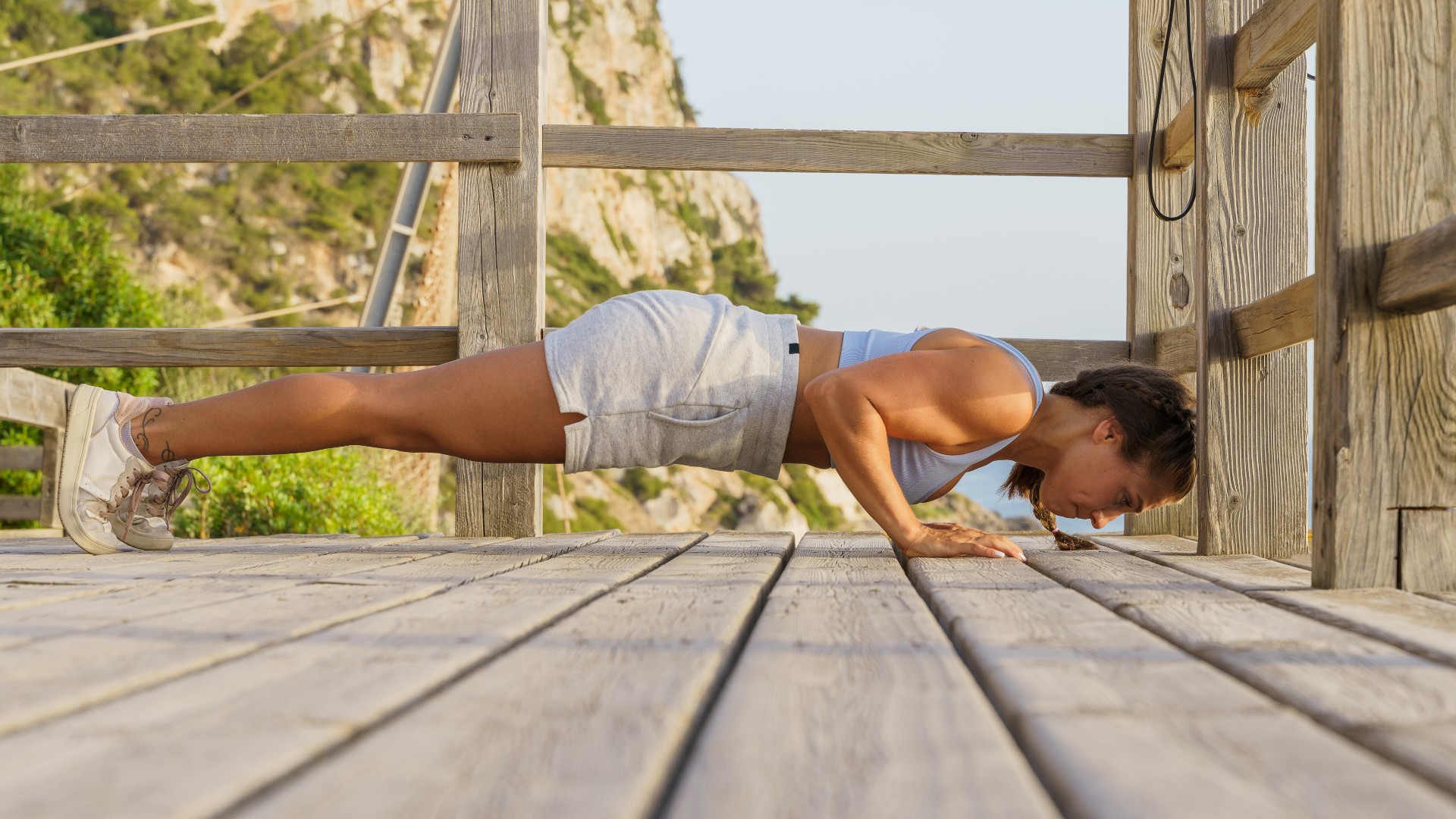
The beauty of push-ups? There are endless ways to scale them. Simple changes to positioning your hands or feet can help emphasize different muscle groups, or you can just load ’em on up to put your muscles through the wringer.
I love a push-up. The bodyweight exercise strengthens your upper body, primarily hitting the pecs, anterior deltoids (fronts of your shoulders), triceps and core muscles. The move develops your pushing power, and certain push-up variations can help you work on explosive strength, benefitting other upper-body exercises like your bench press.
I decided to try for 70 reps of weighted push-ups each day for a week, placing a barbell plate across my mid-upper back and repping it out for 7 sets of 10. Here’s what happened.
What are weighted push-ups?
As the name suggests, weighted push-ups are just push-ups performed either in a weighted vest or with a weight placed on your mid to upper back — never your lower back. Typically, a barbell plate is easiest to keep in position, so you might need a spotter to help you if you go down this route.
It’s a great push-up progression alongside your typical variations like decline push-ups or resistance band push-ups, to name a few.
How to do weighted push-ups
I recommend a weighted vest if you’re trying them alone or using a weight plate if you have a spotter. I opted for the weight plate, positioning it along my mid-upper back:
- Start in a push-up position with hands stacked beneath your shoulders, stomach, quads and glutes braced
- Bend your elbows and lower your chest toward the ground, keeping your elbows tucked close to your body
- Pause, then push upward and extend both arms.
Here’s a more detailed step-by-step guide on how to do push-ups with proper form.
I went to failure faster
As the name suggests, weighted push-ups add weight, working muscles and joints harder through their range of motion.
You can perform reps from your knees, but it would make more sense to get standard push-ups locked down before adding weight. If you need to perform them from your knees, there are plenty of push-up variations that help build the prerequisite strength for weighted push-ups. That said, you could start from your knees and add load progressively when you can perform a number of reps unbroken without your knees.
I split the reps into 7 sets of 10 and boy, did I reach failure fast. Normally, I can manage 10 reps unbroken without drama. With a 5kg plate, however, I was trembling as I reached the end of my reps each round, and 10 reps suddenly felt like 30.
I had to focus on form even more
As soon as muscles fatigue, form begins to decline. If the hips drop, this can indicate a lack of core engagement, which can hurt your lower back. I find narrow push-ups easier as my triceps are quite strong, rather than wide-stance push-ups, which typically hit the shoulders harder.
If the hips drop, this can indicate a lack of core engagement, which can hurt your lower back.
I adopted these while focusing on engaging my core throughout each rep and exhaling as I pushed the ground away. For most of the week, I performed my reps in front of the mirror and took extra rest between sets when I felt my form starting to decline.
Toward the end of the week, I used push-up bars to relieve the pressure on my wrists, although this also meant my chest and shoulders had further to travel to the ground, increasing my range of motion and making the move harder overall, but it did save my sore wrists.

Verdict
My upper body certainly felt it after a week of practice, and I made sure to couple the push-ups with some back work throughout to ensure I didn’t overload one muscle group too much.
I didn't feel particularly sore after each day, but returning to regular push-ups after loading them for a week felt a lot like heaven! I also focused more on the quality of my reps because it was a fairly new exercise, rather than repping it out without thinking like I normally do.
Did I look different? Nope. Sadly one week of push-ups won’t change my physique.
Is it good to do weighted push-ups?

Over time, loaded push-ups will help you increase reps on the standard push-up as they require more strength to shift the weight. Bodyweight upper body exercises also improve functional strength and your ability to perform push-based movements in your daily life. For example, pushing a heavy pram or opening a heavy door.
I love to teach the humble push-up, pull-up and squat the most with clients totally new to exercise. These are incredibly effective movements and an alarming number of people add weight to them before they can efficiently perform them using bodyweight.
That’s why bodyweight versions of exercises are used for weightlifting warm-ups, which is important for push-ups as you engage your chest and shoulders for movement. Many shoulder injuries result from a lack of proper engagement, strength, or shoulder positioning.
So whether you're adding them to warm-ups or using them within your workouts, be sure to practice with your body weight and add load over time.







